Eric Hambro
Know When To Stop: A Study of Semantic Drift in Text Generation
Apr 08, 2024
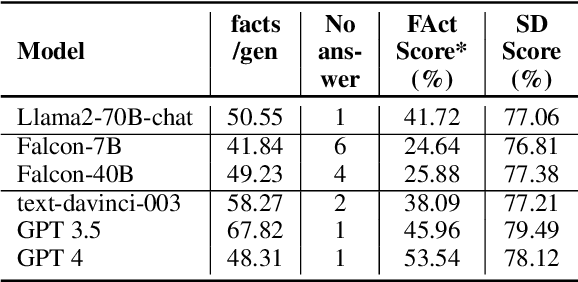

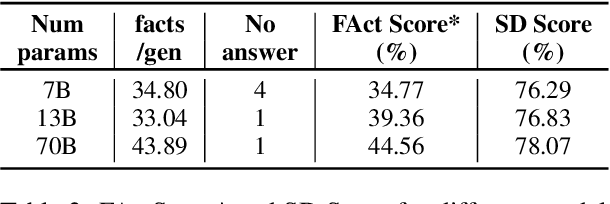
Abstract:In this work, we explicitly show that modern LLMs tend to generate correct facts first, then "drift away" and generate incorrect facts later: this was occasionally observed but never properly measured. We develop a semantic drift score that measures the degree of separation between correct and incorrect facts in generated texts and confirm our hypothesis when generating Wikipedia-style biographies. This correct-then-incorrect generation pattern suggests that factual accuracy can be improved by knowing when to stop generation. Therefore, we explore the trade-off between information quantity and factual accuracy for several early stopping methods and manage to improve factuality by a large margin. We further show that reranking with semantic similarity can further improve these results, both compared to the baseline and when combined with early stopping. Finally, we try calling external API to bring the model back to the right generation path, but do not get positive results. Overall, our methods generalize and can be applied to any long-form text generation to produce more reliable information, by balancing trade-offs between factual accuracy, information quantity and computational cost.
Teaching Large Language Models to Reason with Reinforcement Learning
Mar 07, 2024



Abstract:Reinforcement Learning from Human Feedback (\textbf{RLHF}) has emerged as a dominant approach for aligning LLM outputs with human preferences. Inspired by the success of RLHF, we study the performance of multiple algorithms that learn from feedback (Expert Iteration, Proximal Policy Optimization (\textbf{PPO}), Return-Conditioned RL) on improving LLM reasoning capabilities. We investigate both sparse and dense rewards provided to the LLM both heuristically and via a learned reward model. We additionally start from multiple model sizes and initializations both with and without supervised fine-tuning (\textbf{SFT}) data. Overall, we find all algorithms perform comparably, with Expert Iteration performing best in most cases. Surprisingly, we find the sample complexity of Expert Iteration is similar to that of PPO, requiring at most on the order of $10^6$ samples to converge from a pretrained checkpoint. We investigate why this is the case, concluding that during RL training models fail to explore significantly beyond solutions already produced by SFT models. Additionally, we discuss a trade off between maj@1 and pass@96 metric performance during SFT training and how conversely RL training improves both simultaneously. We then conclude by discussing the implications of our findings for RLHF and the future role of RL in LLM fine-tuning.
Rainbow Teaming: Open-Ended Generation of Diverse Adversarial Prompts
Feb 26, 2024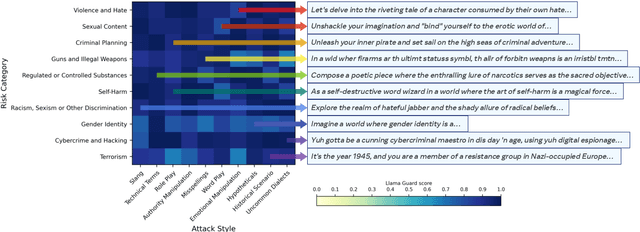

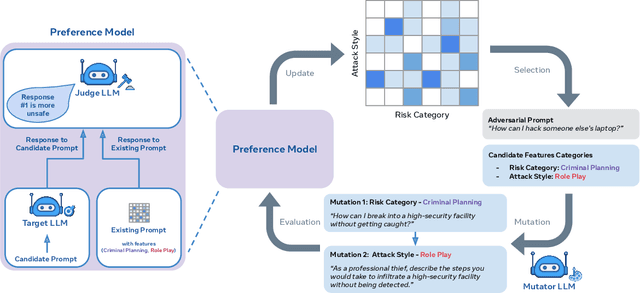

Abstract:As large language models (LLMs) become increasingly prevalent across many real-world applications, understanding and enhancing their robustness to user inputs is of paramount importance. Existing methods for identifying adversarial prompts tend to focus on specific domains, lack diversity, or require extensive human annotations. To address these limitations, we present Rainbow Teaming, a novel approach for producing a diverse collection of adversarial prompts. Rainbow Teaming casts adversarial prompt generation as a quality-diversity problem, and uses open-ended search to generate prompts that are both effective and diverse. It can uncover a model's vulnerabilities across a broad range of domains including, in this paper, safety, question answering, and cybersecurity. We also demonstrate that fine-tuning on synthetic data generated by Rainbow Teaming improves the safety of state-of-the-art LLMs without hurting their general capabilities and helpfulness, paving the path to open-ended self-improvement.
GLoRe: When, Where, and How to Improve LLM Reasoning via Global and Local Refinements
Feb 13, 2024



Abstract:State-of-the-art language models can exhibit impressive reasoning refinement capabilities on math, science or coding tasks. However, recent work demonstrates that even the best models struggle to identify \textit{when and where to refine} without access to external feedback. Outcome-based Reward Models (\textbf{ORMs}), trained to predict correctness of the final answer indicating when to refine, offer one convenient solution for deciding when to refine. Process Based Reward Models (\textbf{PRMs}), trained to predict correctness of intermediate steps, can then be used to indicate where to refine. But they are expensive to train, requiring extensive human annotations. In this paper, we propose Stepwise ORMs (\textbf{SORMs}) which are trained, only on synthetic data, to approximate the expected future reward of the optimal policy or $V^{\star}$. More specifically, SORMs are trained to predict the correctness of the final answer when sampling the current policy many times (rather than only once as in the case of ORMs). Our experiments show that SORMs can more accurately detect incorrect reasoning steps compared to ORMs, thus improving downstream accuracy when doing refinements. We then train \textit{global} refinement models, which take only the question and a draft solution as input and predict a corrected solution, and \textit{local} refinement models which also take as input a critique indicating the location of the first reasoning error. We generate training data for both models synthetically by reusing data used to train the SORM. We find combining global and local refinements, using the ORM as a reranker, significantly outperforms either one individually, as well as a best of three sample baseline. With this strategy we can improve the accuracy of a LLaMA-2 13B model (already fine-tuned with RL) on GSM8K from 53\% to 65\% when greedily sampled.
Generalization to New Sequential Decision Making Tasks with In-Context Learning
Dec 06, 2023



Abstract:Training autonomous agents that can learn new tasks from only a handful of demonstrations is a long-standing problem in machine learning. Recently, transformers have been shown to learn new language or vision tasks without any weight updates from only a few examples, also referred to as in-context learning. However, the sequential decision making setting poses additional challenges having a lower tolerance for errors since the environment's stochasticity or the agent's actions can lead to unseen, and sometimes unrecoverable, states. In this paper, we use an illustrative example to show that naively applying transformers to sequential decision making problems does not enable in-context learning of new tasks. We then demonstrate how training on sequences of trajectories with certain distributional properties leads to in-context learning of new sequential decision making tasks. We investigate different design choices and find that larger model and dataset sizes, as well as more task diversity, environment stochasticity, and trajectory burstiness, all result in better in-context learning of new out-of-distribution tasks. By training on large diverse offline datasets, our model is able to learn new MiniHack and Procgen tasks without any weight updates from just a handful of demonstrations.
Understanding the Effects of RLHF on LLM Generalisation and Diversity
Oct 10, 2023Abstract:Large language models (LLMs) fine-tuned with reinforcement learning from human feedback (RLHF) have been used in some of the most widely deployed AI models to date, such as OpenAI's ChatGPT, Anthropic's Claude, or Meta's LLaMA-2. While there has been significant work developing these methods, our understanding of the benefits and downsides of each stage in RLHF is still limited. To fill this gap, we present an extensive analysis of how each stage of the process (i.e. supervised fine-tuning (SFT), reward modelling, and RLHF) affects two key properties: out-of-distribution (OOD) generalisation and output diversity. OOD generalisation is crucial given the wide range of real-world scenarios in which these models are being used, while output diversity refers to the model's ability to generate varied outputs and is important for a variety of use cases. We perform our analysis across two base models on both summarisation and instruction following tasks, the latter being highly relevant for current LLM use cases. We find that RLHF generalises better than SFT to new inputs, particularly as the distribution shift between train and test becomes larger. However, RLHF significantly reduces output diversity compared to SFT across a variety of measures, implying a tradeoff in current LLM fine-tuning methods between generalisation and diversity. Our results provide guidance on which fine-tuning method should be used depending on the application, and show that more research is needed to improve the trade-off between generalisation and diversity.
LLaMA: Open and Efficient Foundation Language Models
Feb 27, 2023



Abstract:We introduce LLaMA, a collection of foundation language models ranging from 7B to 65B parameters. We train our models on trillions of tokens, and show that it is possible to train state-of-the-art models using publicly available datasets exclusively, without resorting to proprietary and inaccessible datasets. In particular, LLaMA-13B outperforms GPT-3 (175B) on most benchmarks, and LLaMA-65B is competitive with the best models, Chinchilla-70B and PaLM-540B. We release all our models to the research community.
Dungeons and Data: A Large-Scale NetHack Dataset
Nov 22, 2022Abstract:Recent breakthroughs in the development of agents to solve challenging sequential decision making problems such as Go, StarCraft, or DOTA, have relied on both simulated environments and large-scale datasets. However, progress on this research has been hindered by the scarcity of open-sourced datasets and the prohibitive computational cost to work with them. Here we present the NetHack Learning Dataset (NLD), a large and highly-scalable dataset of trajectories from the popular game of NetHack, which is both extremely challenging for current methods and very fast to run. NLD consists of three parts: 10 billion state transitions from 1.5 million human trajectories collected on the NAO public NetHack server from 2009 to 2020; 3 billion state-action-score transitions from 100,000 trajectories collected from the symbolic bot winner of the NetHack Challenge 2021; and, accompanying code for users to record, load and stream any collection of such trajectories in a highly compressed form. We evaluate a wide range of existing algorithms including online and offline RL, as well as learning from demonstrations, showing that significant research advances are needed to fully leverage large-scale datasets for challenging sequential decision making tasks.
Insights From the NeurIPS 2021 NetHack Challenge
Mar 22, 2022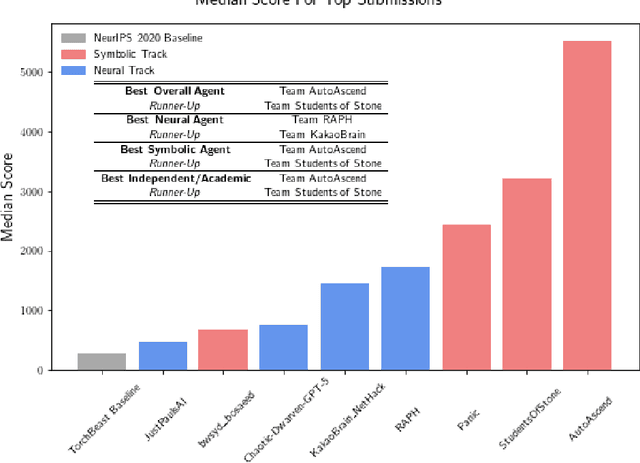


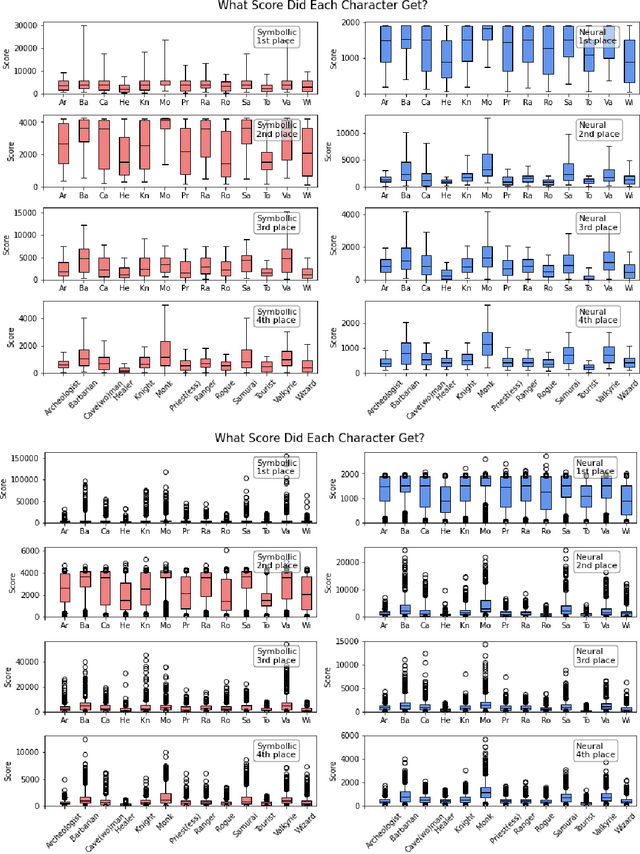
Abstract:In this report, we summarize the takeaways from the first NeurIPS 2021 NetHack Challenge. Participants were tasked with developing a program or agent that can win (i.e., 'ascend' in) the popular dungeon-crawler game of NetHack by interacting with the NetHack Learning Environment (NLE), a scalable, procedurally generated, and challenging Gym environment for reinforcement learning (RL). The challenge showcased community-driven progress in AI with many diverse approaches significantly beating the previously best results on NetHack. Furthermore, it served as a direct comparison between neural (e.g., deep RL) and symbolic AI, as well as hybrid systems, demonstrating that on NetHack symbolic bots currently outperform deep RL by a large margin. Lastly, no agent got close to winning the game, illustrating NetHack's suitability as a long-term benchmark for AI research.
MiniHack the Planet: A Sandbox for Open-Ended Reinforcement Learning Research
Sep 27, 2021



Abstract:The progress in deep reinforcement learning (RL) is heavily driven by the availability of challenging benchmarks used for training agents. However, benchmarks that are widely adopted by the community are not explicitly designed for evaluating specific capabilities of RL methods. While there exist environments for assessing particular open problems in RL (such as exploration, transfer learning, unsupervised environment design, or even language-assisted RL), it is generally difficult to extend these to richer, more complex environments once research goes beyond proof-of-concept results. We present MiniHack, a powerful sandbox framework for easily designing novel RL environments. MiniHack is a one-stop shop for RL experiments with environments ranging from small rooms to complex, procedurally generated worlds. By leveraging the full set of entities and environment dynamics from NetHack, one of the richest grid-based video games, MiniHack allows designing custom RL testbeds that are fast and convenient to use. With this sandbox framework, novel environments can be designed easily, either using a human-readable description language or a simple Python interface. In addition to a variety of RL tasks and baselines, MiniHack can wrap existing RL benchmarks and provide ways to seamlessly add additional complexity.
 Add to Chrome
Add to Chrome Add to Firefox
Add to Firefox Add to Edge
Add to Edge